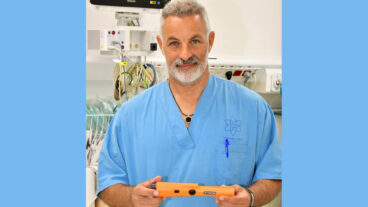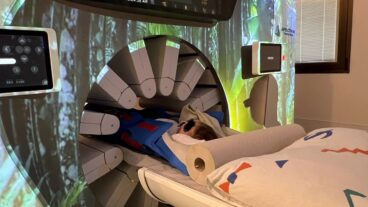Image of a healthy bone (left), and a bone showing signs of osteoporosis – the Hebrew University team was able to demonstrate that the proper loss/generation balance in bone tissue is regulated by the level of activity of interleukin 1 in the brain. For sufferers of osteoporosis, a new study conducted in Israel that determines the brain plays an important role in maintaining proper bone density provides a ray of hope.
The research conducted at the Hebrew University of Jerusalem focused on the activity of the protein interleukin 1 in the brain, and signified not only an important addition to understanding the brain’s regulation of bone density but also holds promise for the development of future treatment for osteoporosis, according to the research team leader Prof. Itai Bab, the head of HU’s bone laboratory – one of the most respected in the world.
Osteoporosis is the most widespread, degenerative disease in the Western world. Characterized by loss of bone density and consequent structural weakening of the skeleton, the condition makes osteoporosis sufferers highly susceptible to fractures, in some cases leading to severe physical disability and complications that can even end in death. More than one in 10 Americans either have, or are at risk of developing, osteoporosis or other bone diseases.
In humans and other vertebrates, one-tenth of the bone tissue is involved in an ‘exchange’ process of continuous bone loss and generation. In adult humans and other mammals, this process is balanced; that is, the amount of bone tissue that is generated is equal to that which is lost, thus preserving bone density. With age, this balance is disrupted, and the amount of bone tissue that is lost is greater than that which is created, with the result that bone density declines and bone structure is impaired.
The interleukin 1 protein has been known for many years as a stimulator of the immune system. In the skeleton the protein causes an increase in the number and activity of osteoclastic cells – the cells that break down bone tissue and which develop from the same cells as those of the immune system.
By experimenting with genetically engineered laboratory mice whose ability to react to interleukin 1 was controlled, Bib and his team, including Prof. Raz Yirmiya of the HU psychology department, and Prof. Esther Shahami of the HU laboratory for the study of brain trauma, were able to demonstrate that the proper loss/generation balance in bone tissue is regulated by the level of activity of interleukin 1 in the brain.
A normal, optimal level of interleukin 1 activity in the brain is required to protect bone density by impeding bone tissue breakdown, say the scientists. An article about their work appeared in the latest edition of the prestigious American journal, Proceedings of the National Academy of Sciences.
“The connection between the brain and the bone structure is a new area of research about which very little is known,” said Bab. “These new findings from our laboratories at the Hebrew University regarding the action of interleukin 1 on the breakdown of bone tissue indicate a complex neural system controlling bone structure and point the way towards new revelations in the near future in this area.”
“Our research clearly demonstrates that the brain regulates the bone remodeling process – this is the first time this has been shown,” Bab told ISRAEL21c. “With this knowledge, the potential is there to eventually develop new treatments for osteoporosis.”
For Bab, the findings are part of a career-long interest in bone research that began in 1978.
“A few studies that have been conducted indicated the brain had a certain level of control of the bone mass and bone selectivity. But it was clear from the few reports out there that this wasn’t the entire picture. Therefore we decided to see what’s really going in, and our findings are revolutionary,” he said.
Bab in his work at the Bone Laboratory – which is part of the university’s Institute of Dental Sciences – has been working on developing new therapeutic and preventive approaches to treat men suffering from osteoporosis.
Osteoporosis is an affliction commonly identified with women, however there are millions of men in the world who also suffer from it. Estimates are that the number of men with this disease is one-fourth that of women.
Among the approaches coming out of the bone lab are preparations that stimulate bone building based on naturally occurring hormones that regulate bone formation.
The bone lab was also responsible for discovering 13 years ago the Osteogenic Growth Peptide (OGP) which was shown in osteoporotic mice to stimulate bone building.
Such accomplishments have propelled the bone lab into the forefront of world research in the field.
“We have only 15 people in the lab, but we’re basically the main research center of this kind in Israel. We share information and research tools with two of the top private labs in world – in Houston and in Germany,” said Bab.












